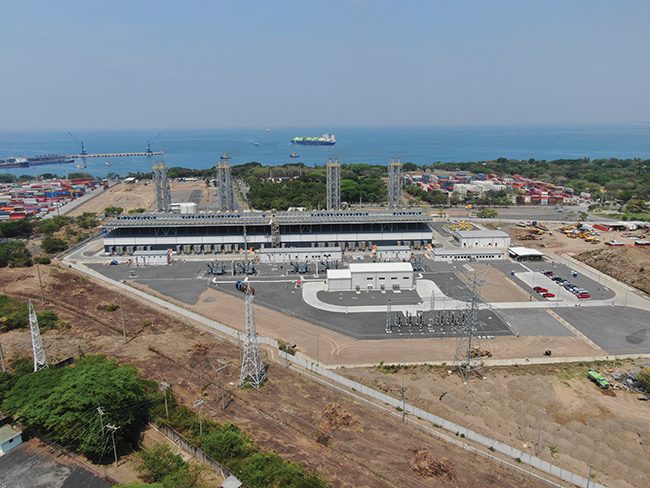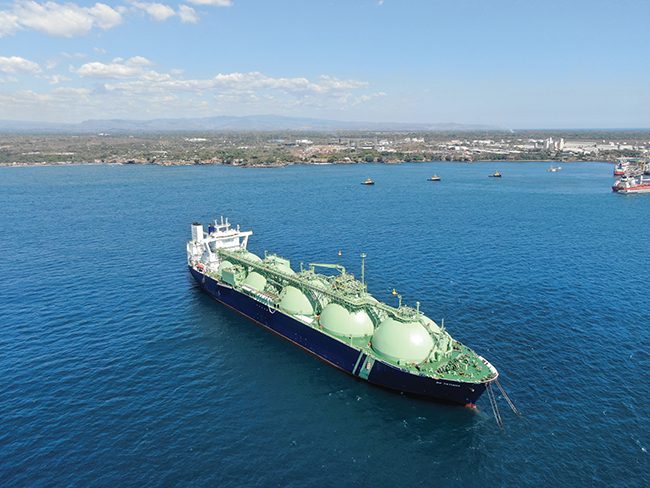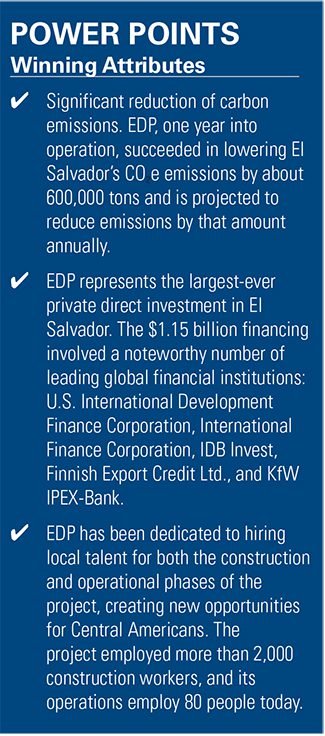Feat of Engineering Provides Floating Power Solution

A project utilizing liquefied natural gas (LNG) is supporting power generation in El Salvador and playing a major role in the country’s energy transformation.
An energy project in El Salvador has been called transformative for the Central American country, which has long relied on hydro and geothermal resources to support its power generation. Government officials are pushing for the country to diversify its energy mix and recognizing that foreign investment is needed to support new electricity-producing projects, both renewable and thermal. It’s against that backdrop that Invenergy, a global energy project developer, joined with Wärtsilä and others to design and build a power generation project unlike any other in the region.
Energía del Pacífico, or EDP—located in the port of Acajutla—is a 380-MW power plant fueled by natural gas, with the fuel supplied via pipeline from an LNG floating storage and regasification unit (FSRU) on El Salvador’s Pacific Coast. The project includes a 44-kilometer (27-mile) 230-kV double-circuit transmission line and associated substations, running from the Acajutla facility to Ahuachapán, a city of more than 110,000 people in western El Salvador. The transmission line also connects the power plant to the Central American Electrical Interconnection System (SIEPAC), an interconnection of the power grids of six Central American countries.
“One of the biggest known challenges at the outset of the project was the fact that there had never before been a gas-fired power plant served by LNG imports in El Salvador, so we needed to create the means of importing and storing LNG,” said Jose Sarmiento, vice president and country manager for Invenergy, EDP’s primary developer, in El Salvador. “Given the complexity and sheer size and scope of this project, we experienced many challenges including permitting hurdles to get the natural gas transported to the power plant.” That included, as Sarmiento noted, “a permanently moored floating storage and regasification unit to regasify imported LNG,” along with “a pipeline bored through volcanic rock.”
The EDP project represents an investment of about $1.15 billion, which is the single largest foreign direct investment in the country’s history. Construction began in early 2020, and the power plant entered commercial operation in May 2022. Sarmiento said, “EDP’s electric generation represents the largest and most efficient thermal plant in the country, providing baseload balance to support the addition of intermittent renewable power resources.”
Construction and Permitting Challenges
Sarmiento told POWER, “A significant permitting challenge was the absence of laws to govern the FSRU installation and the shipments via pipeline to bring the gas to the power plant.” Sarmiento said Invenergy worked with the government of El Salvador “to create and implement the region’s first regulations for offshore gas storage and natural gas transportation to shore. Establishing this critical regulatory framework lays the foundation for future developments that will improve environmental stewardship.”
 |
|
1. Permanently moored at El Salvador’s Port of Acajutla, the BW Tatiana is the first floating storage and regasification unit (FSRU) on the Pacific Coast of the Americas. Liquefied natural gas (LNG) delivered to the FSRU is converted to natural gas that is transported via a 1.8-kilometer subsea pipeline to the onshore power plant. Courtesy: Invenergy |
Sarmiento said another obstacle “was securing a safe and environmentally responsible pipeline route to the power plant. Connecting the FSRU [Figure 1] to shore posed a challenge because El Salvador’s Pacific cliffs are environmentally protected. The location of the onshore power plant could have entailed the pipeline delivering gas from the FSRU to the power station running over a cliff where the line meets the shore. Because of the negative visual impact this route would have introduced, the decision was made to bore through the volcanic rock of the cliff. Traditional methods posed risks, so the team repurposed a micro-tunneling technique from the mining sector and adapted it to drill through solid volcanic rock to connect the FSRU to the power station.”
Sarmiento said, “The offshore LNG terminal is an ongoing energy transition enabler for the country, providing the opportunity to develop additional infrastructure to supply gas to other regional consumers.”
Wärtsilä Engines
The EDP combined cycle power plant features 19 Wärtsilä 18V50SG natural gas–powered reciprocating engines, each rated at 18.9 MW, and one 28-MW steam turbine generator powered by steam produced from the heat recovered from each engine. It is at present the largest, and considered the most efficient, thermal power plant in El Salvador.
The electricity produced at EDP has displaced power generation from burning heavy fuel oil, which is important to the country’s environmental goals. Invenergy officials said the use of LNG at the power plant has reduced emissions of carbon dioxide by 600,000 tons annually compared to burning fuel oil.
The power plant also has reduced El Salvador’s dependency on energy imports from neighboring countries. Officials said the country’s electricity imports from the Regional Electricity Market—which includes El Salvador, Guatemala, Honduras, Nicaragua, Costa Rica, and Panama—have dropped by 70%.
EDP’s 380-MW generation capacity represents about 15% of El Salvador’s total installed capacity of 2,479 MW. Invenergy officials said the plant can cover up to 38% of El Salvador’s peak electricity demand. The plant supplied electricity to cover 20% of the country’s energy demand from May to December of last year.
“The biggest challenge the project faced was unanticipated: COVID-19,” said Sarmiento. “Our ability to complete the project despite myriad roadblocks due to the worst global pandemic in modern history is a testament to Invenergy’s experience and ingenuity in global power project development and the assistance of our local partners.” Sarmiento said factors associated with COVID-19 included supply chain disruptions, as well as “a complete country closure for a period of time and other travel restrictions, as well as global markets’ volatility and economic uncertainty driven by the Russian invasion of Ukraine.”
The contractors and suppliers at EDP include Wärtsilä, which supported design and construction of the power plant. Other companies involved include Elecnor (construction of transmission and substations); Boskalis (construction of marine infrastructure, including pipeline, tunnel, mooring, and riser system installation); BWO (design, supply of mooring and riser system); BW LNG (co-owner with Invenergy of the FSRU, the first to be installed in El Salvador); SAAM Towage (provided tugboats for LNG tankers); and Shell (LNG supplier). Local El Salvador-based partners crucial to the success of the project included Grupo Calleja, VC Energy de Centroamerica, and Quantum Energy.
Community Benefits
The plant is committed to doing more than just supplying electricity for the country and the region, with a 20-year contract to develop infrastructure works and invest in social projects in the surrounding area. Sarmiento said those critical infrastructure projects include:
- ■ The construction of two local roadways and paving/lighting of several others in Acajutla.
- ■ Construction of a new sewage system and wastewater treatment plant in Cantón Metalío.
- ■ Electrification of three local villages: Caserío Los Abetos, canton El Suncita; Caserío Miramar, Metalío canton; and Caserío El Porvenir.
Local schools also have benefited, through remodeling and renovation projects. EDP supported area businesses, in part through building an online platform called “Pa’Servirle,” or “To Serve You,” to help local businesses impacted by the pandemic sell goods and services online. EDP also collaborated with five Acajutla fishing cooperatives, aiding 150 members with boats, equipment, and infrastructure enhancements. The program also trained the groups in cooperativism—or how to work together toward economic and social goals—along with marine product handling, and administrative procedures.
The project also supported construction of Casa Comunal IVU, a new community center and sports complex in Colonia IVU. Sarmiento said that by the end of 2023, the ongoing funding of social projects is expected to reach $3.8 million.
EDP made a commitment to biodiversity in the region, supporting creation of 150 artificial reefs, and two turtle incubation nurseries. It supported a community education campaign on habitat protection of black-eyed frogs, a once-endangered species native to the region.

“This novel project with extensive scope, also required a wide-ranging local outreach,” said Sarmiento. “We conducted comprehensive community engagement through multiple channels to keep our neighbors up to speed with aspects of the project, including town halls with mayors and other local government officials and additional information sessions with communities, with fishing cooperatives and schools. EDP’s continued success in community relations relies on maintaining open, broad and inclusive dialogues within these communities.”
Said Sarmiento: “This is a complex, LNG-to-power project that is truly transformative for El Salvador and exemplifies our global leadership in modern power development. All in all, EDP is an engineering feat and a model for public-private partnership. The creative project represents a blueprint for developing nations struggling to develop their economies and meet energy-transition goals at the same time.”
—Darrell Proctor is a senior associate editor for POWER (@POWERmagazine).